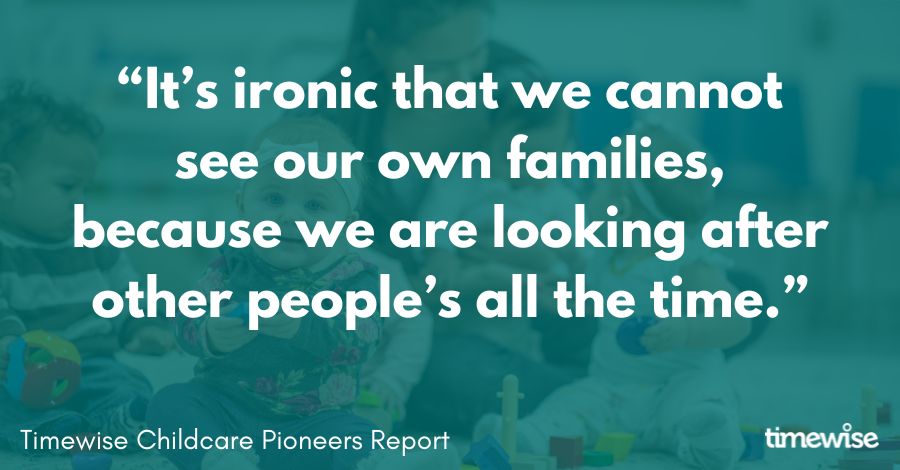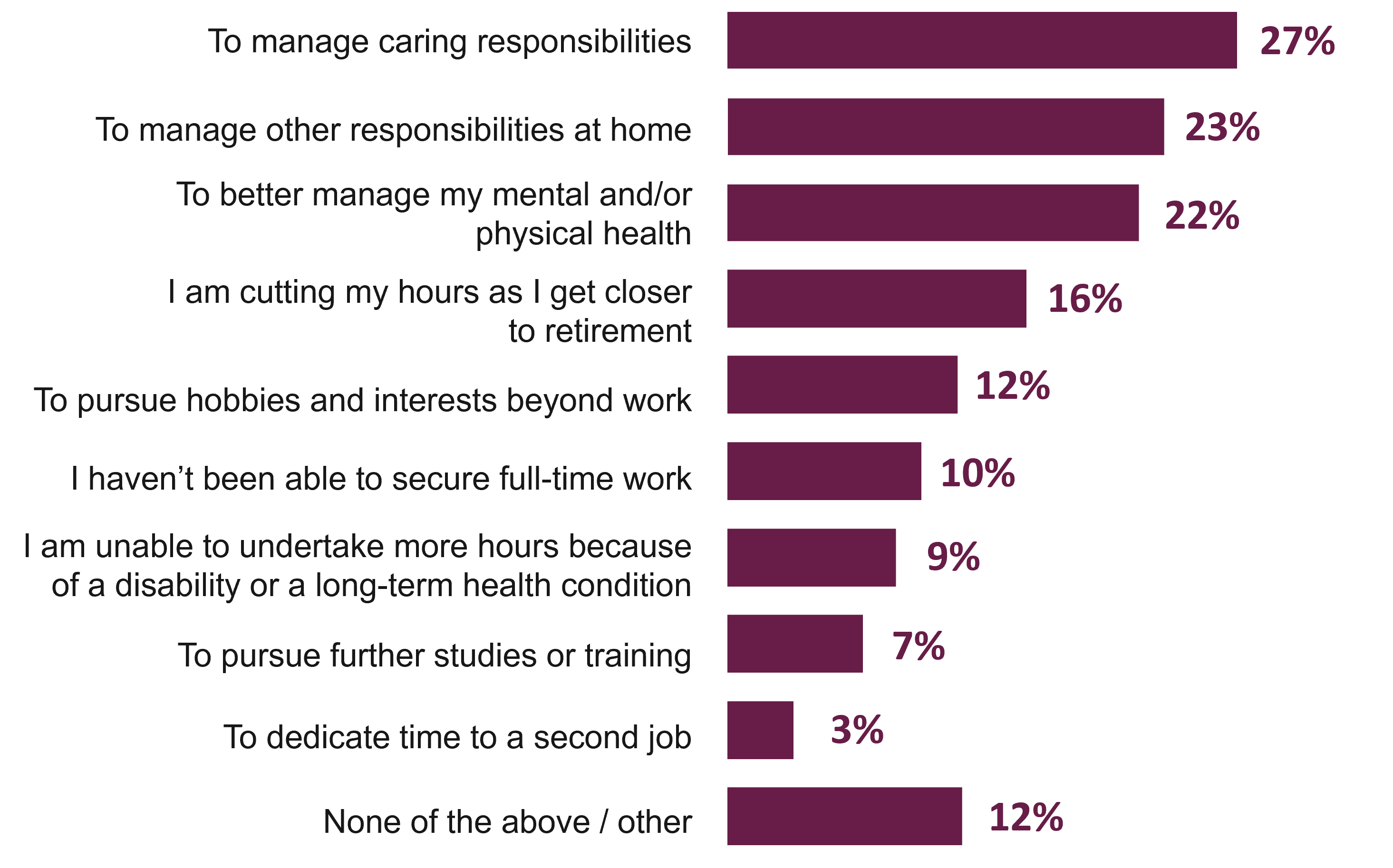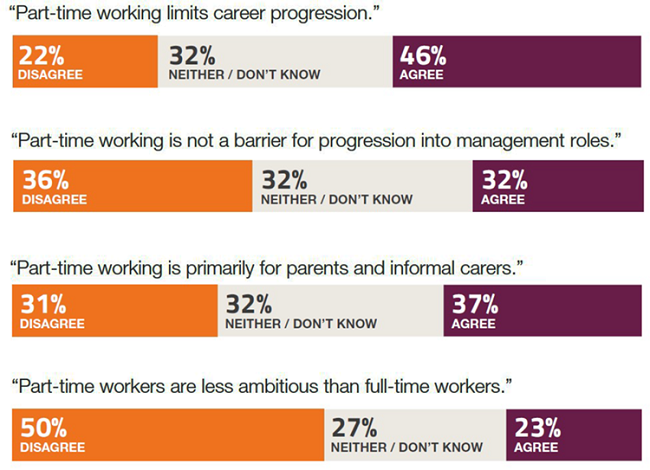

4 in 10 early years educators are leaving the sector - for good. Pay and progression are known issues. Now it’s time to start looking at working pattern, too.

By Nicola Pease, Principal Consultant, Timewise
We can all agree that any functioning society needs an excellent system of early years and childcare provision. At present, our high quality early years educators are managing to provide a great service, but many are stressed, exhausted and have little to no work-life balance. In short, it’s an early years system on the edge.
While issues around pay and progression loom large with no immediate resolution in sight, let’s look to what we can fix. Building on recent successes in other shift-based, site-based sectors such as nursing, construction and retail, Timewise launched a report following an in-depth two-year project in the early years and childcare sector. Thanks to support from JPMorganChase we were able to partner with two leading childcare providers: the Early Years Alliance and the London Early Years Foundation, and get close to childcare staff, in settings.
We analysed the industry’s challenges and assessed its potential with regards to improving staff wellbeing through changes to working patterns. Sometimes, even the smallest changes can make an enormous difference. We conducted all our research and analysis whilst keeping the experiences of children and parents front of mind. If this is going to work: it has to work for everyone.
We held a packed event in Westminster, with support from the Early Education and Childcare Coalition, to launch our subsequent report, Building the early years and childcare workforce of the future, with early years providers, policymakers and local and national government representatives. We collaborated on ideas and sharing ‘what works’ at settings across the UK. All with the experience of children and quality of education and care, front and centre of our thinking. Read on, to find out more…
The early years sector is facing a perfect storm – the expansion of 30 hours funded childcare will require an additional 35,000 staff across the UK, yet 78% of providers in a recent survey said they are already struggling to attract people to a sector that is not competitive on pay or working conditions. 62% of the workforce earn less than the living wage, with pay rates similar to roles in retail and hospitality, that are arguably less physically and emotionally demanding – and sometimes offer more flexibility in terms of what shifts and hours people can work.
There is also an increasing number of pressures on our early years educators which is driving up their workload and making the job harder. For example a growth in the demand for longer-hours provision to meet the needs of parents and (as was raised numerous times at our event), a hugely increased number of children presenting with SEND. All this notches up the pressure gauge.
The research found that nearly two-thirds of staff in group-based settings have said they do not have good work-life balance.

Part-time work across the sector has fallen in the majority of settings since 2018-19 with flexible working options generally achieved through the use of casual, agency or bank staff.
Managers recognised the potential benefits of offering flexible working but were concerned about continuity of care, maintaining staff-child ratios, meeting training standards, ensuring fairness and managing team dynamics. As one person described life in a nursery, “It’s a constant jigsaw.”
At the roundtable we heard a clear call to value those working in Early Years more highly, recognising that, “It’s not just about numbers, it’s about ensuring those who care and educate are energised, valued and motivated to do so.” There was an acknowledgement that emotional resilience is key in a workplace that demands a high level of emotional investment in children’s development and needs. And a sense that there is a need to better balance the workloads and schedules of those in such an intense working environment, to better support physical, mental and emotional wellbeing.
Increasing access and opportunity for the sector is a challenge, but through the research and numerous examples of good practice, it was proven to be possible within the operating constraints of the sector – all with the voice of the child front and centre. Innovative work practices included split-shift patterns (read Ruth’s story on page 11 of the report) and recruiting lunchtime assistants (page 18 of the report), housekeepers or tea-time assistants who enable flexibility across the wider teams. As Neil Leitch, Chief Executive of the Early Years Alliance put it, “You have to be creative. Continuity is critical but that does not mean you need always to see the same person.”
And it can also be used to enhance an organisation’s management capabilities. As June O’Sullivan OBE, the Chief Executive of LEYF said, “We need to think creatively about flexibility, in its wider context. For example, think flexibly about how you think about succession planning. It can help planning the next steps for staff or an experienced manager phase their retirement slowly, while helping a new manager to build their skills and knowledge.”
At a national level, Timewise is calling for a workforce plan that includes flexible working as a key strategic pillar. We estimate that a recruitment drive based around part-time and flexible working could attract staff to fill the equivalent of 17,850 full-time vacancies. That’s half the 35,000 shortfall the UK currently faces, to meet the expansion of 30hrs/week funded support.
Locally, we need authorities to bring networks of childcare providers together to share learnings, consider challenges and how to overcome them by exploring innovative practices such as sharing of bank staff. There was real momentum at our event around this idea – clearly they have a real ‘binding’ role to play. And for childcare providers themselves, we need to see a shift away from an individualised request-response model of flexibility towards a more pro-active whole-setting approach that encourages creativity and innovation and enables staff input into working patterns. To support this, Timewise have created a series of toolkits and resources for managers, which can be found here.
There is no magic wand with which to fix the staff and people problems that the early years sector is facing. But creating good standards of flexible working, in an industry where 98% of employees are women, many of whom have their own caring responsibilities, is not just good business sense. It’s a way to improve wellbeing and the lives of those playing the vital role of nurturing our future generations.

By Amy Butterworth, Consultancy Director
In October this year, the Government published its Employment Bill including the commitment to make flexible working a default right. This builds on the changes made in April this year which made it possible for employees to make a request on day one of their employment.
In terms of how this will be delivered, the Government has essentially tightened up the previous policy, putting more onus on the employer to accept any ‘reasonable’ request. Supporting guidance is expected to make it clear what the consideration process needs to be and to help employers understand how to apply the ‘reasonableness’ assessment.
In terms of supporting organisations to make this change, the key is to make sure it supports employers in delivering their business, as well as supporting individuals. It also important to reference all types of flexible working to ensure that the flexibility can be found which suits the role. This isn’t just about hybrid working. There will be more work to do to support employers to identify the flex that will work in each role and to support teams with multiple people working flexibly.
If delivered correctly, this change could enable thousands more people to access and stay in work. It will also benefit employers in terms of improving wellbeing and morale, and reducing sickness and turnover.
At Timewise, we’ve supported hundreds of organisations to transform their approach and attitudes towards flexible working. And as we’ve proved in our innovation work, there are ways to improve the options and choice someone has, even in shift- based and site-based roles.
Our work focuses on finding the ‘win-win’ where the needs of the organisation and the needs of individuals can be achieved. It involves being willing to look afresh at working practices and being willing to try something new. Being familiar with a whole range of ways to make jobs more flexible. And co-designing solutions with managers and teams.
Now that we know that this change will be happening, we encourage employers to look at their organisational culture and processes to ensure that flexible working is really integrated into how they work. The demand is there, so to reap the benefits of improved attraction and retention, ensure flexible working can be supported in every team and be part of your ways of working.
Published October 2024
Changes in work: zero hours contracts
Changes in work: the right to switch off

By Claire Campbell, CEO
In October the government published its Employment Bill including the right to guaranteed hours, ending exploitative zero hours contracts.
Zero tolerance to zero hours?
The focus on zero hours contracts and banning of exploitative work arrangements, in favour of more balanced flexibility – that works, both for employers and staff, has been a consistent element of the government’s plans since before the election.
The use of zero hours contracts in the UK has been growing and we now have over 1 million people on this type of employment contract as their main job. Although this only affects a small proportion of workers overall, some sectors are heavily reliant upon these contractual arrangements – including food and hospitality, health and social care and transport. Certain groups are also disproportionately affected – figures from the Work Foundation suggest that women, young workers (including those aged 16-24 who are not students), and black workers are all more likely than others to be employed on this basis.
A zero hours contract is one where the employer does not guarantee the worker any hours of work and instead offers work as and when it is available. They have been heralded in the past as the solution to flexible work, but this comes at a price – with only a tiny minority of people employed on these contracts having access to regular pay and rights. 3 in 4 workers on zero hour contracts are in severely insecure work.
The government has stated:
“We’re introducing a right to guaranteed hours reflecting the hours qualifying workers have worked during a reference period, anticipated to be 12 weeks. And we’re also enshrining into law the right to reasonable notice of shifts and a right to payment for shifts cancelled or curtailed at short notice”
Zero hours contracts will not be banned completely, but the rules around them will change. Those on both zero and low hours contracts will gain the right to have guaranteed hours if they work regular hours over a reference period, likely to be 12 weeks.
Workers will be able to bring tribunal claims and be awarded compensation. However, they will also be able to remain on zero hours contracts where they prefer.
Workers will also be entitled to reasonable notice of shifts (including details of how many hours are to be worked and when), changes to shifts and cancellation of shifts, and for payment if shifts are cancelled, moved or shortened.
So what can employers be doing now to prepare for this particular upgrade to workers’ rights?
The issue with zero hours contracts for many people is that they can provide a lot of flexibility for the employer and no stability or security for the individual, as they do not guarantee hours or income and make it hard to predict earnings week to week.
Ask yourself:
The government has opened a consultation on whether and how these rights could be extended to agency workers, which you can participate in here.
Further details will be needed including how long the reference period is, how it will be calculated, and how terms such as ‘regular hours’ and ‘low hours’ are defined.
Detailed, practical guidance will be needed to implement the planned changes, including a clear explanation for employers of what is meant by exploitative, and whether all zero hours contracts are in scope. If zero hours contracts are to be permitted in certain cases, the government will need to set out arrangements for monitoring this and ensuring workers’ rights are protected.
Whatever the detail that emerges, there is a clear ambition and opportunity here to improve the predictability and security of working hours and income for workers, which is a welcome direction of travel. At Timewise we look forward to contributing to the detail of the new regulations, and supporting more employers to create good quality jobs.
Published October 2024
Changes in work: flexible working as a default Day One right
Changes in work: the right to switch off

By Amy Butterworth, Consultancy Director
For too long, the UK has relied on the traditional 9-5, five-day-a-week working model, which we know no longer fits with modern lifestyles. While some industries, usually those with desk-based workers, have adopted flexible working with relative ease, spurred on by the pandemic, others with site-based or frontline workers have found it more challenging and risk being left behind. There is now a growing divide in the UK workforce between those who can work flexibly and those who cannot. Additionally, there is an increasing number of people out of work on sick leave, and employee burnout is on the rise too. With retention rates and employee wellbeing topping many leadership teams’ to-do lists, could flexible working be the answer?
Here at Timewise, we’ve long called for trialling different ways of working as we know the traditional 9-5 doesn’t work for everyone. That’s why we’re thrilled to be actively involved in the 4 Day Week campaign’s second pilot, which begins this Autumn. The second pilot has been expanded to give organisations greater opportunity to experiment with different kinds of flexibility, which aligns with the work we do, especially with front-line and site-based workers. Can the newly evolved four-day week trial pave the way for more flex, especially in traditionally hard-to-flex roles?
The first four-day week pilot saw 61 organisations move to a four-day week without a pay loss for workers. Organisations reduced working hours by an average of 6.6 hours to reach a 31.6-hour week and gave their employees one full day off a week, either on a universal or staggered basis.
The results led almost every company (92%) to continue with a four-day week, with many citing its positive effects on employee wellbeing, business performance and improved retention. While the initial pilot reaped encouraging results, it’s important to note that the majority of people involved were desk-based workers. From our experience, time-based flexibility can be challenging to manage and it’s unlikely this ‘one-size fits all’ approach will work for all organisation types and workers.
Which is why we’re thrilled the 4 Day Week campaign is evolving to give organisations the opportunity to try different kinds of flexibility. This could be shorter working weeks, flexible start and finish times, a nine-day fortnight, or compressed hours. As this is our sweet spot, we had to get involved and lend our knowledge and experience to the programme. We believe this new pilot will give organisations with ‘hard-to-flex’ roles the opportunity to innovate in a low-risk way as we know from our pilots in a range of sectors, including construction, nursing, retail and teaching. And we also know that changes to make flexible working more widely available can pay for themselves in just a few years through reduced sickness absences and improved staff retention.
The 4-Day Week campaign is an opportunity for organisations to get creative, especially those that have frontline or site-based workers, who have traditionally hard-to-flex roles. It comes at a time when we’re hearing of more organisations trialling new ways of working, which can only lead to more data and better decision-making as a result.
South Cambridgeshire District Council recently experimented with a shorter week for desk-based workers before expanding its trial to include refuse collection workers. Despite criticism, the Council continued with its plans, which saw changes to routes, collection days and extra staff. This has resulted in fewer sick days, less absenteeism, and better overall retention.
Another example is retailer Wickes, who we worked with to pilot a new approach to flexible working. The pilot made flexible working a reality for store managers, which had a knock-on effect on the company’s ability to attract and keep staff. It’s now being rolled out to more managerial roles.
We firmly believe that pilots are valuable. They allow organisations to test and develop innovative workplace solutions, learning and fine-tuning along the way, before committing to rolling out new ways of working, increasing the likelihood of success and sustainability. We have extensive experience in this area and will be sharing key learnings and watch-outs with pilot organisations.
Organisations of all types are encouraged to sign up for the six-month pilot, which begins in November. Throughout the pilot, organisations will benefit from support and guidance, tailored to their needs. The University of Cambridge, Boston College, and the Autonomy Institute will conduct an impact analysis and the results will be presented to the Government in Summer 2025.
This pilot is an exciting opportunity for organisations to innovate and implement flexible working arrangements that support their employees’ needs. The experiences and results from this pilot can pave the way for others too, especially in industries that are reluctant to flex. Timewise’s CEO Claire Campbell, said: “This is a great opportunity to trial something which will benefit worker health and retention. Whether you work in a warehouse, a care home or behind a desk – we foresee a fairer flexible future for all and the first employers to step forward for this trial, will be a part of that.”
Find out more about the 4 Day Week Campaign pilot.
Published August 2024

UCLH is a large teaching hospital, part of the Shelford Group, which has over 10,000 staff working across 10 London sites. The leadership team is keen to create a work environment in which staff feel valued, encouraged and supported, and as part of this, has sought to explore how to improve work-life balance.
Like many organisations, UCLH implemented remote and hybrid working for office-based staff during and after the pandemic. However, there are unique operational constraints in some patient-facing and clinical areas, mainly wards and teams delivering 24-hour services. Hybrid working was not a viable flexible working option for ward staff and the leadership team felt it was important to find other ways to offer flexibility for these teams. This was reinforced by a survey in 2021, which revealed that 51% of staff felt they had a good balance between work and home life, and just 48% felt that UCLH was committed to helping them balance these two elements.
Following this feedback, UCLH launched a new flexible working policy in 2022, which offered a more proactive approach to flexible working. This included the implementation of a new electronic rostering system, which in turn opened up opportunities to explore innovative approaches for ward-based staff.
However, the team felt they needed to bolster local resources with dedicated external expertise to drive the project forward, including the support of someone with experience in delivery. A member of UCLH worked with Timewise on a previous project at another NHS Trust and approached us to provide support for the self-rostering project.
Our team worked with UCLH to pilot a self-rostering approach, which allows staff to select their preferred shift arrangements and days off. These requests build a draft roster, which is then reviewed and adjusted (if necessary) by the ward manager / senior nurse. On completion the roster is 1st level approved by the ward manager followed by a 2nd level approval by the matron. It gives staff more input and control into the shifts they work, and makes the rostering process easier, and quicker, for the ward managers.
We agreed to pilot this approach with four wards of varying sizes, which were spread across two sites, and represented different clinical divisions and ward size. Approximately 152 staff were involved.
Working closely with the UCLH team, an integrated project team was created. We began with a research phase that looked at existing workforce data, and explored how the staff on the four wards were currently using the system. We then brought representatives from each ward together to work with us to design the pilot, setting out the principles and etiquette that would allow self-rostering to run smoothly.
We also sought to engage directly with the ward managers and matrons from each ward, knowing that they would be responsible for managing the new roster on a day-to-day basis, and for fielding questions about how to use it. And we created a range of resources for the UCLH intranet, which set out the parameters of the project, explained how to use the roster and answered common questions.
Having sought to get everyone on board, we then ran the pilot across the four wards for three months. Feedback was gathered through ward visits and surveys, and fed into a formal evaluation of the pilot, which could be used to steer a potential wider rollout.
We identified potential challenges before we began the pilot, such as the technology limitations, and the ‘first-come-first-served’ nature of the system being potentially contentious. However, the roster team provided the necessary training to ensure the rostering technology could be used effectively. The project team presented and communicated clearly the ‘etiquette’ involved in this new approach to rostering – encouraging staff to consider the impact of the shifts they were selecting on the wider team, by drawing on the Trust values. This helped mitigate these potential problems, none of which turned out to be issues during the pilot itself.
We did encounter some implementation challenges as the pilot developed. For example, although self-rostering should be used to book shifts or days off, some staff began using their allocations as a way to book time off work, instead of going through the annual leave process. Similarly, while each shift needed a senior nurse to select the nurse in charge shift some staff were not booking into these shifts. This impacted the overall shape of the roster and so the issues were addressed, and both of these were quickly overcome through conversations at a local level.
In terms of outcomes, we sought to evaluate how many staff were using the new roster approach to input their preferred shifts, and how many were approved. By the end of the pilot:
Critically, this new way of rostering was used by all staff groups, though slightly less by the unregistered staff. Positively, the ward managers reported they saved time, due to a large proportion of the roster already being populated before they got involved and had fewer swap shift requests after roster publication.
The UCLH team provided a detailed evaluation of the pilot, and approval was obtained to rollout self rostering across the nursing teams within the Trust.
Following the successful pilot, self rostering has been rolled out to the nursing teams in a further 43 wards across two hospital sites. The only exceptions are the emergency and critical care units (three wards) who had recently established their own specialist rostering arrangements including rolling rosters.
In order to enable roll out at this scale, the 43 wards were grouped into six cohorts, who went live with self rostering in a phased pattern across a period of six months. Timewise supported the UCLH project team and steering group to agree the roll out approach, standardise roster rules and get the engagement, training and comms right, building on our learning from the pilot. A valuable addition for the roll out was the appointment of a ward advocate for each ward, whose role was to support the project team and the ward managers by liaising with nursing colleagues, ensuring people understood the new approach, and flagging any issues or concerns early so that the roll out could progress smoothly. The steering group met monthly to monitor progress, measuring take-up and approval rates and ensuring they were in line with the high levels achieved in the pilot.
The nursing roll out is now complete, and some non-nursing teams across the Trust are starting to express interest in this way of working and exploring the benefits it could have for them also – watch this space!
Claire Stranack, HR Business Partner at UCLH, has this advice for anyone considering a similar project:
Inge Cordner, Lead Nurse for Nursing & Midwifery Workforce, has some additional suggestions from the frontline:
Timewise brought a huge amount of experience and resources and supported us at every stage of the process. They acted as a critical friend, supporting and facilitating design and engagement sessions, and driving the project forward at a pace we could not have achieved alone. There is no way we could have delivered this pilot within this timescale without Timewise’s involvement.
Claire Stranack, Human Resources Business Partner at UCLH
Often working in the NHS we have so many competing priorities that you can often be pulled in many directions. Someone outside of that space, supporting with external expertise, as provided by Timewise, meant we were able to hit the ground running whilst being able to build our own organisational knowledge at the same time. The project was well managed and enabled us to use our time efficiently. Thank you, Amy!
Inge Cordner, Lead Nurse for Nursing & Midwifery Workforce, UCLH
Published June 2024, updated May 2025

By Amy Butterworth, Consultancy Director
The year ahead is set to be a big one for working practices. The right to request flexible working from the first day in a new job will come into effect on 6 April – something we’ve long been calling for (and would love to see go further). And there are strong indications that we will see a change of government, to a party whose intentions include extending workers’ rights, closing major employment gaps, and implementing a right to switch off.
Outside of these two big changes, what does 2024 hold? Here are some of the flexible working trends we will be keeping a close eye on this year.
Recent months have seen an intensification of efforts by some employers to increase the amount of time their employees spend in the office. From a top City law firm tracking when employees enter and leave their headquarters, to Nationwide scrapping its ‘work anywhere’ policy, the direction of travel is towards a more structured approach of set days on which employees are expected to be in the building.
However, despite a slew of articles blaming the WFH culture for everything from delaying HS2 to shrinking the car market, few organisations have mandated that their employees must come back full-time. And according to a British Chambers of Commerce and Cisco survey, only one in four companies expect their staff to be in the office full-time in the coming years.
Understandably, employees are keen to retain the home-work balance that they gained following the pandemic; the cost of living crisis has also made people extra keen to limit their commuting costs. And as the protests from Amazon employees over a return-to-office mandate have shown, they are unlikely to give WFH up without a fight.
We are firm advocates for the value of in-person time, believing that cohesion and collaboration are improved when team members spend some of their working time together. But we also believe employers need to take steps to ensure they deliver that value, and create a culture in which employees are supported to make both their in-office and remote time count. And that setting an arbitrary number of days that people need to come in, without thinking about what they are coming in for, isn’t the right way to go about it.
The evidence suggests that a degree of WFH is here to stay, and it’s in employers’ interests to accept it; as Clare McCartney from the CIPD has noted, “It’s likely that organisations are going to struggle to attract and keep talent if they want people in the office full-time, five days a week.”
Early 2024 will see new measures introduced which aim to reduce net migration – but will also reduce the pool of people coming from abroad to work.
The policy change means that people coming to the UK on health and care visas will not be able to bring dependents with them (the NHS is not affected). It also increases the minimum salary threshold for employees coming to the UK on a skilled worker visa from £26,200 to £38,700, which will hit sectors including hospitality and manufacturing.
The immigration minister Robert Jenrick has accepted that we “will see a reduction in the number of people coming to work in social care from overseas” and that “we hope and expect [vacancies] will be filled by British workers”. But there are already a large number of economically inactive adults in the UK; last year’s ONS figures put it at around 9 million people, of which 1.7 million said they want a job. So employers in these sectors will need to be more creative if they want to encourage homegrown talent to fill these roles.
Flexible working is a powerful talent attraction tool, and the lack of it can make people leave; the CIPD found last year that 4 million people had changed careers due to a lack of flex. And while some of the affected sectors are location-based (and so less compatible with remote working), there are a range of other options.
So, employers who are serious about attracting UK residents back into work would be wise to think outside the box and explore the viability of arrangements such as part-time and compressed hours. We’ve made flex work on construction sites, and have been exploring a range of options with Wickes; creative thinking can make the seemingly impossible possible.
January saw the news that Asda is trialling a four-day working week, as part of a drive to hold on to in-store managers. Asda is one of the biggest organisations to run this kind of trial so far, and is doing so as part of a ‘case for change’ which will also explore shorter shifts and other flexible arrangements.
Interest in the four-day week has grown at pace since the results of a six-month pilot involving 61 companies were published last year. And it’s certainly popular with employees; Gartner research noted that 63% of candidates surveyed ranked it as their top offering, and online bank Atom Bank saw a 500% increase in job applications immediately after announcing it was introducing a four-day week for its 430 staff.
However, there has also been a government backlash towards public-sector organisations who have carried out trials, with South Cambridgeshire District Council (SCDC) ordered to end theirs by the local government minister, and being issued with a ‘best value notice’ when they refused to do so.
We’re fully behind the drive to experiment with different flexible working models, and believe pilots are an excellent, lower-risk way to do so. And while we don’t agree with the Gartner analysis that 2024 is the year that the four-day week goes from radical to routine, we hope and expect to see more examples of four-day week trials in the year ahead. We’ll be keeping a close eye on the SCDC pilots (due to finish in March this year), and on whether other public sector organisations take the plunge despite the censure that SCDC received.
These are just three examples of how 2024 is likely to be a year of meaningful change in working practices; and our work to drive that change will continue. We’ve got some exciting projects to share with you, including a listening project supported by Phoenix which will explore part-time experiences.
We’re also increasing our focus on ways of working to support inclusion. One such project involves us working in partnership with Runnymede to research the relationship between flexible working and ethnicity (supported by Impact on Urban Health).
And of course, we’ll be working with more employers and sector groups to design, test and implement sustainable flexible working, both for office-based and frontline employees. How will the flexible working market look by the end of 2024? We can’t wait to see.
Published January 2024

Michelmores, an all-services law firm with 450 staff and offices in Exeter, Bristol, London and Cheltenham offers agile working (a combination of working in office and at home) to all staff, where possible in the role. Prior to the pandemic, Michelmores had many individual flexible arrangements and sought to accommodate staff requests when possible.
During the pandemic, during which almost all of Michelmores’ staff worked from home, HR and the senior partners foresaw that they would need to re-imagine the workplace once the return-to-office started. It was difficult to know what the range of options should be and to anticipate their implications. They wanted support in developing new ways of working and to engage staff in the process.
Michelmores came to Timewise looking for an expert view, the wider context of what was happening in the greater labour market and thoughts on how to plan ahead. Colette Stevens, HR Director at Michelmores, says: “Timewise have a real depth of understanding of all the different flexible working options, what the implications would be of pursuing them and a strong commitment to understanding Michelmores’ needs, context and ambitions. Timewise gave us a framework and process within which to explore ideas, challenge thinking and think about different options.”
Timewise convened a working group, made up of Michelmores’ Managing Partner Tim Richards, HR Director Colette Stevens and other senior partners. This team developed the firm’s Agile Working framework with Timewise’s input and guidance. Fairness sits as a core principle within this framework: the goal is to provide all employees with the opportunity to balance working from home and in the office, as agreed within their teams. The framework provides a practical structure, as to the ‘how’. By way of guiding values, the group wanted to ensure that:
Team leaders were tasked with helping to identify any underlying issues and collaboratively working through the implications of agile working in detail with their teams. The agreed framework was rolled out for a year-long trial, with regular feedback from staff at all levels.
Recognising the critical role of managers, Timewise ran bespoke training sessions to help them feel capable and confident in implementing the agile working framework for their teams. Timewise then worked closely with the project team to facilitate follow up review sessions a few months into the trial, for managers to share good practice, seek support and ask questions.
The agile working approach adopted by Michelmores has been a great success, with over 80% of staff expressing satisfaction with how they can work, giving them greater choice and freedom. Set this against the wider context of the pandemic’s impact upon the legal profession. A 2021 study by Gartner of 202 corporate lawyers found 68% were ready to start looking for a new job.
Michelmores prides itself upon enhanced talent attraction. It now offers a more flexible approach than many other law firms, and this is having an impact on its reputation as a great employer. As one recent joiner comments: “The flexibility offered was a huge factor in my decision to join Michelmores. My previous firm wanted fixed three days in the office, and my commute is long.”
It has also created the opportunity to attract candidates from a wider geographical area than before. Another new joiner says: “…being sure agile worked in practice was my first question. It meant I could join and not have to relocate.”
Michelmores continues to monitor and evolve its agile working approach, including understanding the impact on new joiners such as these and developing induction and onboarding processes to suit new ways of working. Valuing the different office sites and bringing people together in person continue to be important for the organisation as it grows. Working in an agile way encourages teams to use office time more intentionally and the Michelmores agile working approach, with the flexibility that it brings, is now firmly part of the organisational culture.
Colette Stevens, HR Director of Michelmores, summarises: “Timewise really listened to what we were grappling with and what was important for us. They helped us co-curate our approach to agile working and differentiate what we can offer the market.”
Published January 2024

By Sarah Dauncey, Head of Partnerships and Practice
Is part-time the forgotten flex? It certainly appears so. While hybrid and home working have been at the forefront during and since the pandemic, there’s been little, if any, focus on part-time. This is despite the fact that almost a quarter of the workforce (8 million people) work reduced hours, and that many people, particularly parents, carers and those with health issues, can only work if they can find a part-time role.
Here at Timewise, we’ve been championing part-time for almost 20 years, including by proving that part-time doesn’t mean part-committed through our much-respected Power List. But our concern that the need for, and value of, part-time work were being ignored spurred us to find out what part-time work really looks like today – and what it ought to look like in the future.
Backed by the Phoenix Group, Lloyds Banking Group and Diageo, we’ve carried out a large-scale study, A Question of Time. This saw us survey 4,001 workers, and run four focus groups, so we could understand how part-time work is perceived and experienced across the labour market, and how those experiences and attitudes vary by gender, age, class, ethnicity and other demographic factors. We also included some analysis of the Labour Force Survey, the UK’s largest study on employment services.
What we learned from our new evidence is that the picture is highly complex, with big disparities between how different age groups, gender groups, ethnic groups, and income groups experience and perceive part-time. We’ve always argued that there is no one-size-fits-all solution for flexible working, and this study certainly confirms that approach. Here are some of our key findings – and why they point to ‘fluid flexibility’ as the best way forward for employers and employees alike.
These are just some of the issues highlighted in our research; you can find more data and insights in our report. But, of course, the next question has to be, what should be done about it? If we believe that part-time is a valid working arrangement (which we, and forward-looking employers and policymakers certainly do) then how can we ensure it’s more widely available and doesn’t hinder career progression?
The short answer is: we need a more fluid approach to flexibility. One that better supports employees to manage their work / life balance, while acknowledging that one-size-fits-all doesn’t even apply to one person throughout their career, let alone to a workplace as a whole.
After all, just because someone wants to work part-time when they have a young family, it doesn’t mean that they won’t be able to increase their capacity at a later date. And just because someone has worked full-time throughout their career, it doesn’t mean they might not prefer to work part-time to ease into their retirement. So, as one of our older research participants put it:
“There needs to be a flexible approach to flexibility – a rethinking of it so that working arrangements can be adjusted more easily. (…) Jobs need to be designed more flexibly and fluidly to respond to people’s needs and changing life circumstances.”
Employers who understand this will be better able to attract staff, and from a diverse range of backgrounds, retain them, and enable them to thrive. And they can make this possible by:
There are many more recommendations in our report, including some for policymakers, which we don’t have room to include here. But they all point to one thing: if we want to get part-time and flexible working right, the answer is fluid flexibility, which gives people more choice and control throughout their working lives.
Published December 2023
The aim of A Question of Time is to capture the whole picture of part-time working in the UK, right now. It’s not a simple story.
In partnership with Opinium, we surveyed both full-time and part-time 4,001 workers and undertook focus groups to gain a deeper understanding of people’s experiences of and views on part-time working.
There’s a mixed story of blocked career paths, conflicting views – and a glimpse of hope (see our video).
Reduced hours are seen as a central way to manage life and health needs. But there are distinct cultural and economic barriers to overcome. Part-time work is perceived to limit career progression, particularly among the ‘gatekeepers’ of career success: managers.
Yet, ironically, managers are the most likely occupational group to express an interest in working part-time in the future.
In this report, we shine a spotlight onto people’s experiences and perceptions of part-time working to contribute much needed new insight into labour market inequalities. By gathering a deeper understanding of the realities of part-time work, and differing attitudes towards it, we’re better able to direct action to deliver change, improving the lives of workers by granting them greater flexibility and choice.
Part-time employment is prevalent in the UK, especially among women. However, there has been a slow decrease in women’s participation in part-time work, and a slight increase in men’s.
41% of people work part-time to manage either care or home related responsibilities, and 22% work part-time to better manage their mental and/or physical health. The findings highlight the gender inequalities associated with caring responsibilities, yet also draw attention to the health crisis.

Covid has changed things. People want to pursue interests beyond work. Part-time shouldn’t just be for parents.
YOUNGER WORKER, FOCUS GROUP PARTICIPANT
Nearly half of all survey respondents believe part-time working can limit career progression, and over a third of workers consider it to be primarily for parents and carers, rising to 1 in 4 among those in the managerial occupational group.

Differences in the perception of the status of part-time work by age, ethnicity, education and occupation include:
While half of the survey respondents would be happy to talk to their employer about changing their working arrangements, 30% would not be comfortable discussing reduced hours. Of the respondents, younger workers and those with temporary contracts were least comfortable discussing changing their working arrangements. However, this group were more likely to consider taking advantage of the new day one right to request flexible working in a future role, and significantly more respondents from black minority ethnic groups than white ethnic groups would do the same.
The focus groups supported these findings as well as highlighting that workers were more comfortable discussing working arrangements once more established in their role, with a build up of trust between employer and employee.
At junior level, it’s difficult to discuss flex but as you become more senior and gain trust and respect, it’s easier to pursue it. The ‘right to flex’ is seen as a reward for good work and being trusted. It’s something you earn and isn’t something you automatically have.
OLDER WORKER, FOCUS GROUP PARTICIPANT
Our new findings show there’s a strong demand for part-time working, regardless of gender, occupation and income, and it has a key part to play in tackling societal challenges such as managing health and wellbeing and the increased burden of social care. There is an urgent need for joined up action by employers, policymakers and government to tackle inequalities in the part-time labour market and create more inclusive workplaces where employees can thrive.
So what can employers do today to make a difference?
Timewise is grateful to our corporate supporters for making the project possible: Diageo, Lloyds Banking Group and Phoenix Group.
Published December 2023
Watch the Timewise A Question of Time webinar below:

By Clare McNeil, Director, Timewise Innovation Unit
The explosion in flexible working as a result of the pandemic – particularly in its home and hybrid working forms – had a clear impact on the number of flexibly advertised jobs. After creeping up by a percent or two each year from our first Flexible Jobs Index in 2015, just 15% of roles were advertised with flexible options in 2019. By 2022, that number had doubled to 30%.
It’s therefore disappointing to see from this year’s Index that this rate of growth has dramatically slowed. Our research indicates that 31% of job adverts now overtly offer some form of flexible working; a negligible change from the previous year, and a big drop from the kind of increases we’ve got used to. And even the growth in the number of home and hybrid working jobs that are advertised as flexible – which went up 9% between 2019 and 2022 – has stalled.
So does this mean that we’ve hit a peak in the proportion of jobs that are advertised as flexible? Is this it? We’re clear that it mustn’t be.
The fact is, the need and demand for flexible working are as strong as ever. Although the vacancy peak of 2022 is slowing, economic growth continues to be held back by a tight labour market, and in many sectors, including healthcare, education and hospitality, staff shortages are at critical levels. Given that 9 in 10 people want to work flexibly, and 4 million UK employees have changed careers due to a lack of flexibility at work, it seems hugely short-sighted that employers are failing to use flexible working to attract new staff.
It’s not just about getting employees in, either; flexible working has a huge part to play in creating strong, healthy workplaces in which people stay, and thrive. It’s been shown to improve health and wellbeing, increase inclusion for key groups (including parents, carers and people with health issues), reduce absenteeism and even boost productivity. What’s more, our research has indicated that the changes required to offer flexible working can pay for themselves in just a few years, through reduced sickness absence and improved staff retention.
All of which makes it surprising that more companies aren’t including flexible working in their talent toolkits. And with new legislation due to be introduced in spring 2024, which gives people the right to request flexible working from day one in a new job, it really is time for employers to get off the fence and start proactively offering it to new employees at the point of hire.
So how can we get back to a position where the number of flexibly advertised jobs is increasing at a more promising rate? Our Flexible Jobs Index sets out a number of actions that employers and policymakers can take, including:
These changes, and the others recommended in our report, could reboot the growth in flexibly advertised jobs, and get us back on the path towards a flourishing economy, powered by a healthier, more equal workforce. Let’s not lose the momentum that we gained during and after the pandemic; we need to keep moving forwards, and we need to start now.
Published November 2023